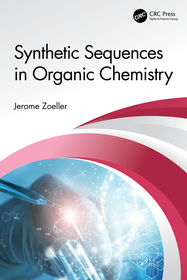
Synthetic Sequences in Organic Chemistry
- Publisher's listprice GBP 57.99
-
27 704 Ft (26 385 Ft + 5% VAT)
The price is estimated because at the time of ordering we do not know what conversion rates will apply to HUF / product currency when the book arrives. In case HUF is weaker, the price increases slightly, in case HUF is stronger, the price goes lower slightly.
- Discount 20% (cc. 5 541 Ft off)
- Discounted price 22 163 Ft (21 108 Ft + 5% VAT)
- Discount is valid until: 31 December 2025
Subcribe now and take benefit of a favourable price.
Subscribe
27 704 Ft

Availability
Estimated delivery time: Expected time of arrival: end of January 2026.
Not in stock at Prospero.
Why don't you give exact delivery time?
Delivery time is estimated on our previous experiences. We give estimations only, because we order from outside Hungary, and the delivery time mainly depends on how quickly the publisher supplies the book. Faster or slower deliveries both happen, but we do our best to supply as quickly as possible.
Product details:
- Edition number 1
- Publisher CRC Press
- Date of Publication 15 September 2023
- ISBN 9781032502939
- Binding Paperback
- No. of pages194 pages
- Size 234x156 mm
- Weight 360 g
- Language English
- Illustrations 238 Illustrations, color; 238 Halftones, color 2256
Categories
Short description:
Chemists faced with the need to make a compound often have minimal exposure to the synthetic literature. Even synthetic experts do not have every reaction at the tips of their fingers. This unique volume contains an enormous range of synthetic reactions from real examples.
MoreLong description:
Drawing on the vast amount of experience the author has gained from working in industrial and university laboratories, this collection of excerpt reports contains essential details from literature relevant to the synthesis of compounds on a milligram to kilogram scale. The excerpts are composed using ChemDraw software and compiled in a Word document. A number of the compounds that have eluded efficient preparation in the past are now presented. Material which will improve any chemist's existing synthetic methodology can be found here. Each of the six chapters, with eighty excerpts, illustrates a novel application of syntheses selected from twenty-first-century literature.
Features:
- This professional text describes many of the classical and contemporary methods of synthesis that have recently found great value in the preparation of needed target compounds in the required quantities.
- This special topic work is a description of the preparation of chemicals used in the study and development of medicinal compounds. Each of the seventy-seven excerpts are graphical outlines of sequential reactions and intermediates used to produce the synthetic targets. A wide variety of classical and modern methodologies are included in this collection. Many of the excerpts are supplemented with experimental details and mechanistic insights into the reactions involved.
- This user-friendly professional text provides enormous aid in designing synthetic sequences.
- Appeals to a broad audience in both academic and industrial laboratories, basically any chemist in need of designing a synthetic sequence or just selecting a single reaction.
- Author has a vast amount of experience gained from working in academic and industrial laboratories.
Jerome Zoeller’s book, Synthetic Sequences in Organic Chemistry, follows in the tradition of E. J. Corey’s The Logic of Organic Synthesis with examples from the literature that illustrate the synthesis of natural and non-natural organic compounds, the placement of “structural moieties” and functional groups, and how synthetic sequences are simplified and diversified using synthetic examples selected by the author. He also gives examples of twelve named reactions in selected syntheses that use them. The last chapter provides illustrations on “how an optimal synthetic scheme can be developed from a discovery synthesis using an original retrosynthetic design.” This book provides useful examples through which synthetic strategies can be illustrated. They come from carefully selected recent examples provided by diverse original sources. Textual explanations are clear, and the ChemDraw illustrations make the synthetic steps easy to follow. This book offers interesting examples using modern synthetic methodology, great for those interested in organic synyjesis.
- Michael Doyle, Ph.D., The Rita and John Feik Distinguished University Chair in Medicinal Chemistry, The University of Texas at San Antonio
MoreTable of Contents:
1. Non-Natural Oranic Compounds. 2. Structural Moieties and Functional Groups . 3. Natural Products. 4. Diversification and Simplification. 5. Name Reactions. 6. Variations on a Synthetic Sequence
More



